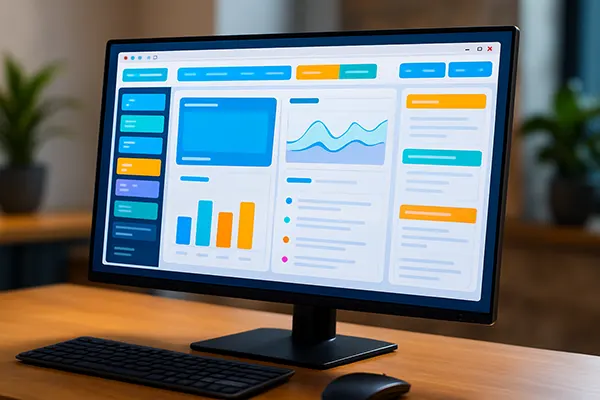
Adaptive User Interfaces: How UX Flexibility Is Transforming Desktop Applications
The evolution of user interfaces is reshaping the way we interact with traditional desktop applications. From static, one-size-fits-all layouts to dynamic, context-aware environments, adaptive UX is no longer a futuristic concept—it’s a fundamental shift happening right now. In this article, we examine how variable interface technologies are changing software usability, productivity, and accessibility on desktop environments.
The Shift from Static to Adaptive Desktop Interfaces
For decades, desktop applications followed a fixed layout model, assuming that all users operated under similar conditions. This design paradigm often neglected users with specific needs, such as multitaskers, those using multiple monitors, or individuals with visual impairments. Adaptive interfaces aim to resolve these limitations by dynamically modifying content and layout based on user preferences, screen size, and behaviour patterns.
One key innovation is responsive scaling. Programs now automatically detect screen resolution and adjust UI elements accordingly. This ensures that features remain usable and visible whether the user is working on a compact laptop or a high-resolution display. Accessibility is improved, and cognitive load is reduced, making workflows more intuitive.
Another driving factor is the inclusion of AI and machine learning within UX design. Modern applications learn from user interactions over time—identifying frequently used tools, predicting actions, and adjusting interface components for efficiency. This results in a deeply personalised environment that evolves alongside the user’s habits.
Examples of Adaptive UX in Popular Desktop Software
Microsoft Office is one of the most prominent examples of adaptive UX in desktop applications. The Ribbon interface introduced in recent versions adapts based on task context. If a user is editing a table in Word or formatting a chart in Excel, the relevant options are automatically brought to the foreground.
Adobe Creative Cloud tools like Photoshop and Illustrator employ modular interfaces that allow users to rearrange and save workspace layouts. These layouts can even change automatically depending on the type of project. For instance, a user working with 3D content sees a different default setup than one editing photographs.
In the development world, integrated development environments (IDEs) like Visual Studio Code adjust panes, toolbars, and extensions based on usage patterns. Code suggestions and debugging tools appear where and when they’re most likely to be needed, streamlining the user experience and improving developer productivity.
Accessibility and Inclusivity through Adaptive Design
Beyond convenience, adaptive UX plays a crucial role in making software accessible to users with diverse physical and cognitive conditions. Variable interface components allow screen readers to interpret layouts more accurately, and font scaling ensures legibility for users with impaired vision.
Speech recognition, now built into many desktop systems, complements adaptive design. By recognising commands and tailoring responses visually, systems can serve users who rely on voice rather than traditional input methods. This is particularly valuable in assistive technology contexts, such as for users with motor impairments.
Additionally, colour scheme adaptations are increasingly integrated. Dark mode, high-contrast mode, and user-defined colour palettes support a range of vision requirements and environmental lighting conditions. These settings are often auto-applied based on time of day or operating system preferences, further enhancing usability.
The Role of User-Centred Testing in Accessibility UX
Developers today prioritise real-world user testing, especially among populations often excluded from early-stage design processes. Through feedback loops, adaptive systems continue to improve post-launch, ensuring evolving compliance with international accessibility standards like WCAG.
Software like Zoom and Slack has embraced user-led adaptation. Zoom adjusts its interface to prioritise features depending on whether a user is hosting or attending a meeting. Slack allows extensive interface customisation to meet individual workflow preferences, improving communication efficiency and accessibility.
This user-centred approach empowers individuals to configure their environments to match both their needs and working style, closing the gap between general usability and personalised efficiency.

Challenges and Future Directions for Adaptive UX in Desktop Applications
Despite the advances, adaptive UX presents unique design and technical challenges. Balancing customisation with usability can be difficult—offering too many options may overwhelm users, especially those less technologically confident. Clear onboarding and guidance are essential when introducing flexible interfaces.
Security is another area of concern. Adaptive features often rely on data collection to function optimally. Developers must ensure that user privacy is respected and that data handling complies with regulations such as GDPR and CCPA. Transparency about how adaptive behaviours are determined helps build user trust.
Looking ahead, the trend leans toward universal interfaces that work seamlessly across operating systems and devices. The integration of gesture recognition, haptic feedback, and context-aware AI will likely define the next phase of adaptive UX, making software smarter and more intuitive than ever before.
Integration with Emerging Technologies
One promising direction is the convergence of adaptive UX with augmented reality (AR). Desktop applications that overlay interface elements in AR environments could adapt not just to screen size, but also to user posture, gaze, or movement. This opens doors for industries like architecture, medicine, and education.
Another emerging field is biometric-driven interfaces. Using sensors that detect user stress levels, attention, or fatigue, applications could adjust visual load, suggest breaks, or reduce animations automatically. Such integrations could drastically improve user well-being and long-term engagement.
Ultimately, adaptive user interfaces will become a cornerstone of software development, shaping a future where each user’s experience is tailored, efficient, and inclusive by default—not as an add-on.
